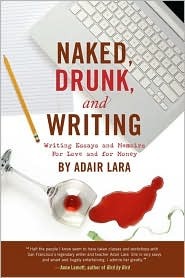It was a pleasure to welcome Adair Lara as guest author for the spring 2012 session of my online course Memories into Story: Introduction to Life Writing (University of Toronto in partnership with the New York Times Knowledge Network). Adair is the San Francisco–based author of the memoir Hold Me Close, Let Me Go, and of Naked, Drunk and Writing: Shed Your Inhibitions and Craft a Compelling Memoir.
Following are some of her thoughtful answers to my students’ interview questions.
On the nature of memory . . .
Nothing is less reliable than memory. My own son has a strong memory of my being taken from the house in an ambulance when he was a little boy. It happened not to me, but to the mother of a friend. He just grafted his own fears of something happening to his parents onto the event he witnessed.
Memories are important because they are what you remember. What you remember is who you are. So as a writer you aren’t saying, “This is the way it happened.” You’re saying, “This is the way I remember it.” You can bring in a brother who remembers it completely differently.
For my son, my departure in an ambulance was real — it was an emotional event that helped shape him.
Pretty much, whenever anybody uses dialogue in writing a scene from the past, he or she is writing fiction. That’s the new deal in creative nonfiction: we accept that memory is creative. You are writing the emotional truth, not the literal truth.
 On writing bravely and openly about one’s life . . .
On writing bravely and openly about one’s life . . .
It’s an interesting thing, but if you speak honestly about something that happened to you, and show the meaning you found in it, then it becomes not a window into the writer’s life, but a mirror in which the reader sees her own. I would know, for example, if a piece about my father worked when a reader started talking to me about her father. That’s the mirror. If she talked to me about my father, then the piece failed, became gossip or pointless confessional material.
On writing about emotional experiences . . .
Certainly a challenge in writing memoirs is often insufficient detachment — you’re still defending yourself, or still smarting, or still royally pissed. When something happens this is what you feel: Wow! Unfair! I am upset! Not a great place to write from, unless you imagine that the reading public will feel the injustice of what happened as keenly as you do, and nod along to your every sentence, ready to rush over to your house and take your side in the lawsuit.
You have to write about those events from a distance, with detachment — writing about intense emotions, but not still feeling them as strongly as you did.
How do you achieve detachment on your own life? You could try writing it in third-person — the idea being to remove the event to a distance. If it’s very painful, you might consider not writing about that particular event. Just go around; tell yourself that you’ll come back to the part where the baby died, or whatever. You might not need to write about it directly anyway. Just go on to what happened next, and let the shell-shocked emotions of that previous event be revealed in how the boy lines up his carefully glued models and shoots them with a BB gun, or something (always good to make emotion indirect when you can — the reader likes to pick up things for herself).
Think of it as material. The you that lived through it is not the you now, looking back. An author looking back remembers the anguish of being fired and ejected from the building, but doesn’t feel it — he is handling the event now as material: Why did it happen? What do I see now that I didn’t see then? How does this scene function in the book?
It could be that the event is too fresh. You are too angry or sad to write about it yet. In that case you should put it aside for a while.
On using imagery . . .
When I wrote a column, I used to challenge myself to get an image into every sentence. It’s not always possible, but just trying to do that made my writing better. Instead of my just saying that my son didn’t like his present, I’d have to show him nudging his new chess set under the couch.
On using dialogue . . .
Use dialogue when the reader has to hear characters say it. You can write, “After that her father told her he’d be away for three days,” but you wouldn’t want to write, “After that her father said he never wanted to see her again.” That has to be in direct dialogue: “I never want to see you again,” he said. Dialogue is immediate. Readers love it. Use indirect dialogue or paraphrase when what is being said is too uninteresting for us to have to hear it directly. People greeting each other and offering each other coffee, for example — that’s dialogue we don’t need to hear.
Read also “5 MORE Tips on Writing Creative Nonfiction from Author Adair Lara.”
* * *
 ADAIR LARA is a writer, teacher and author in San Francisco. A former magazine editor, she wrote a popular, award-winning personal column for the San Francisco Chronicle for 12 years before leaving the paper to write and teach full time. Her most recent book, which has become a cult favourite in the writing blogsphere, is Naked, Drunk and Writing: Shed Your Inhibitions and Craft a Compelling Memoir or Personal Essays (Ten Speed). She holds sold-out workshops in her house on writing essay and memoir and other forms of autobiography, and consults with authors individually, in person or long-distance. Her essays appear in many national magazines, and have been anthologized in dozens of textbooks. She writes a monthly column for Grandparents.com.
ADAIR LARA is a writer, teacher and author in San Francisco. A former magazine editor, she wrote a popular, award-winning personal column for the San Francisco Chronicle for 12 years before leaving the paper to write and teach full time. Her most recent book, which has become a cult favourite in the writing blogsphere, is Naked, Drunk and Writing: Shed Your Inhibitions and Craft a Compelling Memoir or Personal Essays (Ten Speed). She holds sold-out workshops in her house on writing essay and memoir and other forms of autobiography, and consults with authors individually, in person or long-distance. Her essays appear in many national magazines, and have been anthologized in dozens of textbooks. She writes a monthly column for Grandparents.com.

From Sandra Shaw Homer:
“This one was especially helpful, Allyson. Memory automatically makes one an ‘unreliable narrator’!”
From Gail Rudyk:
“Thanks for this, Allyson. I definitely want to get her book!”
Adair’s image of our writing being a mirror for the reader’s life rather than a window into the author’s own helps answer the question “what does the writing mean?”– feedback that always held some mystery for me as a memoirist, until now. Thanks, Allyson! Dace